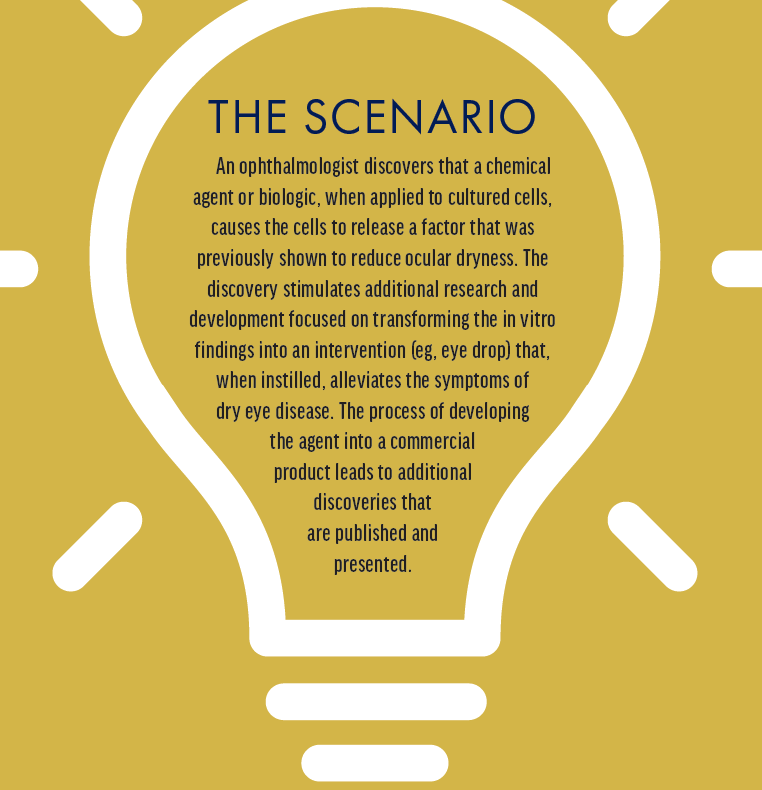
The technology transfer process begins with an early-stage discovery and ends with a commercial product. Patent law has a major impact on the entire process.
PATENT APPLICATIONS
Academia and pharmaceutical companies enjoy open lines of communication. Most inventors at universities and companies collaborate to share ideas, promote discoveries, and enhance existing technologies. Once a discovery is made, inventors disclose information to find buyers—or licensees—that will be able to commercialize the invention. Communication is necessary to the commercial development of an invention, but there are reasons to maintain secrecy regarding a newly discovered technology.

No. 1: Timing matters. One way to protect an invention is to file a patent application. A problem arises when inventors wish to both publish data and file a patent application on the same technology. The US Patent and Trademark Office (USPTO) awards a patent to the inventor who files a patent application first. If two inventors file patent applications on the same technology, then the one with the earlier filing date is eligible to receive a patent. The other is barred from obtaining the same or a similar patent.
Publishing data on an invention before filing a patent application poses a risk. A third party could read the publication and file a patent application on the same or a similar technology. Companies and investors, moreover, are less likely to fund the development of an invention that is barred from patent protection.
To explain the process and the role of patent law, this article uses an imaginary scenario set forth in the accompanying sidebar (at left). In this example, it would be prudent for the ophthalmologist to file a patent application on the chemical or biological agent before publishing or presenting data on it.
No. 2: An idea must be novel or not obvious, or it is not patentable. A publication that discloses the elements of an invention before a patent application is filed may be a bar to patentability. For example, if an article describing all the elements of the eye drop is published before a patent application on the drop is filed, then the USPTO could argue that the invention is not novel. If multiple journal articles, each describing some elements of the eye drop and, together, describing it thoroughly, are published before the filing date of the patent application, then the USPTO could argue that the invention is obvious.
No. 3: Patent rights are highly desirable. Patents give the inventor, or applicant, a period of commercial exclusivity to make, use, and sell products claimed in the patent. This period can enhance product sales and the chances of capturing a large share of commercial markets.
For example, if the inventor of the eye drop is the first to make the discovery, does not publish an article on the technology until after a patent application has been filed, and is the first to file a patent application, then they are likely to receive more funding for research and development and greater future financial rewards from product sales.
DEVELOPMENT AND COMMERCIALIZATION
Finding a buyer. After filing a patent application, the next step in the technology transfer process is to identify a licensee willing to purchase and further develop the technology. In the case of the fictitious eye drop, partnership with a licensee who is an expert on finance, management, sales, and the marketing of eye drops could allow the inventor to focus on research and development.
Sometimes, large companies license and sell a technology because they do not create products that are part of a commercial pipeline. For example, if the fictional eye drop was developed by a company outside the ophthalmology space, the product would be transferred to experts at commercializing drops in the ophthalmology market.
Buyers of inventions are found in many ways. Within a university, the faculty member who made the invention is responsible for finding a buyer. The inventor meets with industry leaders at scientific meetings.
Alternatively, business development professionals read the published literature to look for promising innovations and identify inventions at universities. Typically, a business developer contacts the university directly and provides a list of technologies they wish to purchase. The university works with the business developer and helps to identify an inventor whose inventions best match the needs of the company. Most companies search for both novel technologies and those that augment their product pipelines.
Regarding the fictitious eye drop, the business developer and the university inventor would discuss the eye drop’s potential applications and the specific goals of the company.
Contract negotiations. A successful exchange of information between a business developer and university inventor leads to contract negotiations of a licensing and/or sponsored research agreement. The negotiations are successful once the parties agree on a price. Buyers and sellers consider several factors when determining value. In the presented scenario, the factors would be as follows:
- The amount of money used by the inventor to develop the eye drop;
- The amount of money that will be required to develop the eye drop into a specific commercial application;
- The amount of money that will be required to bring the eye drop to market;
- The number of competitors already selling similar products; and
- The strength of the patent portfolio covering the eye drop.
Once the parties agree on a price, subsequent contract terms may be developed. The price increases if an innovation is close to becoming a commercialized product. Unique or pioneering innovations such as clustered regularly interspaced short palindromic repeats, or CRISPR, are valued higher than innovations that are improvements on preexisting technologies.
PATENT ENFORCEMENT
Another way to increase the price of an invention is to enforce patent rights. Patent holders can enforce patents against third parties infringing on their technology to stop them from making, using, and selling products covered under the claims of the patents. In so doing, the patent holder can eliminate competition, increase market share of a patented product, and enhance financial returns by increasing sales of the patented product. All of this can increase the value of a patented product and the price a buyer is willing to pay to acquire the invention.
A word of caution: Patent litigation is extremely expensive and requires careful consideration. The patent holder must determine that a competitor’s product is unequivocally covered by the claims of the patent(s). Patent claims describe an invention in specific terms, and they are used by courts to determine the breadth, or metes and bounds, of an invention.
It is important to have a patent attorney draft patent claims that avoid ambiguous terms. It is also worth hiring a patent attorney to compare patent claims to the elements of a potentially infringing product. Let’s go back to the eye drop described at the outset of the article. A competing product appears to be infringing, but when the claims of the patent are compared to the elements of the competing product, one or more of the claim elements are missing from the competing product. In this situation, the competing product would be deemed noninfringing by a court, and the patent holder would have spent a lot of money on litigation with no reward.
CONCLUSION
The technology transfer process from innovation to intervention includes the following steps: discovery, patent applications, development and commercialization, and possibly patent enforcement. Each step is complicated, but the process is exciting and rewarding.




